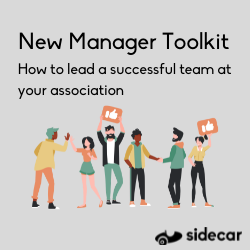As organizations begin recovering from the last two years of a pandemic, retention and employee engagement continue to be a challenge. Faced with the dangers of COVID-19, many workers have changed their outlook on work along with their priorities, forcing organizations to look at their own culture to help stop the Great Resignation.
In our Guide to Retaining Talent, we’ll dive into many of the factors causing this mass exodus, the tough questions organizations need to be asking and strategies to boost retention.
Is Retention On the Decline?
As organizations deal with changes stemming from the pandemic, retention and resignations continue to be significant issues. More than 19 million US workers have left their jobs since the start of the pandemic, and according to data, “Fifty-three percent of the employers said that they are experiencing greater voluntary turnover than they had in previous years, and 64 percent expect the problem to continue—or worsen—over the next six months.”
This “Great Attrition” has led organizations to a crossroads as they determine what needs to be done to improve retention.
How can this impact the association industry?
- Increased Onboarding Costs: Per The Society for Human Resource Management (SHRM), the average replacement cost of a salaried employee is about six to nine months’ salary. That means an organization may spend double or triple the amount it would take to simply invest in training existing staffers. Additionally, organizations need to consider the hidden costs, including the time and effort to find talent, interviews, training and productivity loss as a new staffer gets up to speed.
- Reputation and Cultural Impact: With the advent of review sites and job boards, your organization’s reputation is public, which can affect hiring. Additionally, losing talented individuals can put a hamper on the staff left behind. According to a Netsuite article, “Just as concerning is the contagious nature of turnover. Employees may decide to leave because they notice others are job hunting, talking about quitting or actually leaving the company.”
- Innovation and Problem Solving: More often than not, the staffers who leave are the ones providing your organization with unique ideas and helping you conquer those tough challenges. Because these staffers understand the intricacies of your association, losing them could set back innovation and stunt your ability to provide value for members.
- Member Experience: In most cases, staff members are tasked with interacting with members daily. As an example, if a staffer in charge of accreditation chooses to leave, it can slow down or entirely halt processes, affecting the careers of your members along with the reputation of your association.
Employer Disconnect: What Staffers Actually Want
When looking at retention trends, a significant problem is organizations don’t truly understand why their staffers are leaving. Instead, they are looking for a quick solution, which is only reinforcing frustration among their staff.
The Things Workers Want
According to a McKinsey & Company study, they also want “a renewed and revised sense of purpose in their work. They want social and interpersonal connections with their colleagues and managers. They want to feel a sense of shared identity. Yes, they want pay, benefits, and perks, but more than that they want to feel valued by their organizations and managers.”
What’s Causing Employee Turnover?
- Stress: According to Gallup’s State of the Global Workplace: 2021 Report, “62% of female workers in the U.S. and Canada say they experienced stress a lot of the day the previous day, compared with 52% of male workers.” And the same goes for younger workers, with 64% of workers under 40 feeling stressed daily. Burnout continues to be an issue for workers and without any way to combat their stress, they are either leaving the workforce or looking for alternatives.
- Work-Life Balance: During the pandemic, many organizations transitioned to a work-from-home dynamic. These blurred lines between work and home life have hurt work-life balance, a leading cause for resignations. As organizations look for ways to improve retention, establishing specific work hours and creating a return to work plan can help.
- Talent Supply: Another reason workers are leaving and organizations have a hard time replacing them is talent and skills. According to data from Deloitte, while many of the job losses during the pandemic were in low-wage sectors, “the demand for skilled workers is growing, with seven in 10 employers globally saying they are struggling to find workers with the right mix of technical skills and human capabilities.” For associations, this can be a problem, as the number of professionals with a background in the sector is limited, increasing their demand and options for employment.
- Values: As workers look to find meaning in their careers, it is critical to find a job that aligns with their values. Business and leadership coach John Spence says “aligning someone’s personal core values and vision for their life with the values and vision for the organization” can move companies forward and help keep staff invested in their work.
- Career Opportunity: Research from Robert Half found that “nearly 4 in 10 professionals surveyed (38%) feel their career has stalled since the start of the crisis. That number jumps to 66% for workers ages 18-24.” And from those professionals interviewed, their frustration stemmed from stagnation in career advancement. For organizations, assessing whether or not there is a career trajectory for your staffers is essential. If there is no room for growth and no defined career path, chances are staffers will look for it elsewhere.
6 Factors Your Staffers Are Watching
Once organizations understand what problems impact retention, they also need to understand what their staffers are looking for to stay put.
- Fair Pay: Pay is often the first thing to frustrate an employee, which is why offering a fair and competitive salary is important. Organizations should pay attention to what the market is offering and ensure they are not significantly behind. Creating a track where employees can expect raises, bonuses and promotions can help make salary a non-factor for retention.
- Meaningful Work: Spence says, “people will get out of bed in the morning, go to work for a paycheck; they’ll jump out of bed and go do their best work for a purpose.” Creating a brand promise and sticking to it can help organizations create a more meaningful work environment. Additionally, getting your employees involved in creating that brand promise makes them even more invested in the outcome.
- Cool Colleagues: As some organizations begin to return to the office, team building becomes more important than ever. Workers want to be around people they respect, enjoy and learn from. According to Spence, “if you put somebody on a team with mediocre people, they’ll get frustrated and leave or become mediocre.” Be sure that your staff works well together and pushes each other to be better.
- Great Culture: Generally speaking, staffers spend more time at work than at home, which means the culture and environment they work in is essential for their happiness. Having a safe environment when they are actively listened to and encouraged can go a long way to creating a welcoming environment for them to work in.
- Personal and Professional Development: Growing employees needs to be done professionally and personally. On the professional side, organizations need to provide opportunities to learn new skills, offer access to mentorship and provide internal training. On the personal side, is there a career path they can see? Retaining talent starts with ensuring they have a future in the organization to begin with.
- Leadership: Staffers old and new want to work with leadership they trust, respect and admire. Are your leaders empowering staffers? Are they actively working to make the lives of staffers stress-free and rewarding? If a staffer’s immediate manager is actively adding to their stress, they will be actively looking for a new job as well.
Leaders Impact Retention More Than Anything
Leadership will be the most significant factor for most employees in your association when deciding whether or not they’ll stay. John Spence says, “more than 80% of people that quit their job, don’t quit the company, don’t quit the hours, don’t quit the pay — they quit their immediate boss.”
The managers and leaders within your organization are the main touchpoints for staffers. They are directly responsible for establishing culture, assigning work, and integrating teams, which is why they often have the most prominent role in your staffers’ happiness and stress levels.
Investing in manager training can be one of the quickest ways to turn the tide on retaining talent.

New Manager Toolkit
As organizations begin recovering from the last two years of a pandemic, retention and employee engagement continue to be a challenge. Faced with the dangers of COVID-19, many workers have...
Download Now
5 Questions Associations Should Ask to Boost Retention
For organizations to stop employee turnover, they need to ask tough questions to see where they can improve.
1. Are we providing benefits that actually matter?
According to survey respondents who had left their jobs, 45% cited the need to take care of family as an influential factor in their decision. They also added that family care was a leading cause for people thinking of quitting.
Developing family-focused benefits, such as in-house childcare or daycare stipends, can help alleviate some of the issues leading to resignations.
Having an open dialogue and asking for feedback from staff can be the easiest way for organizations to understand the needs and benefits that staffers need today.
2. Have we invested in employee training?
One of the top strategies to improve retention is always going to be training and professional development. This can include sending staffers to conferences, bringing in expert speakers, or using subject matter experts within the organization to help train hard and soft skills.
Unlock the power of Sidecar for your entire association.
Learn moreAdditionally, establishing nurturing mentorship programs can help grow your employees, which can increase productivity and success for your organization.
3. Do we have a good culture?
When discussing turnover and employee retention, most experts will point to culture as the main factor. The bottom line is people need to be happy working for an organization and get the recognition they deserve.
Spence suggests purposeful recognition as a simple strategy to help improve culture. Look for three staffers and give them genuine and specific praise for a job well done. Similarly, recognizing milestones big and small, instituting awards like employee of the month and showcasing staffer achievements all contribute to an exciting and healthy work culture.
4. Are we being flexible?
While some companies are creating “trophy offices” to bring workers back, the bottom line is flexibility is here to stay.
Depending on the association, returning to the office is essential for daily operations. However, for a vast majority of organizations, this is not the case, and when faced with the possibility of returning to work, many employees will choose to look for an alternative.
To avoid this, organizations should do more to create flexibility. Remote work is not just about being able to work from home – for some staffers, this flexibility is essential for their families or personal wellbeing.
Create options. Whether that’s flexible start times, fully remote options or hybrid alternatives, working with your employees will ensure they keep working for you.
5. Do we have the right leadership team?
As mentioned above, your leadership is one of the most important factors for retention. While there are a few different qualities that make good leaders, the most important thing is their emotional quotient or EQ.
This can be a challenge for many associations as they may still have leaders with a command and control mentality, giving orders and demanding that staffers follow.
Spence says leadership is now focused on servant leadership. “A leader realizes it's not all about me, it's me serving other people. It's not me telling people what to do. It's me asking them, how can I help you?”
Leaders should be more focused on providing authentic feedback, transparent decision-making, and investing in their employees’ professional and personal well-being.
‘Stay Conversations’ and Other Retention Strategies
One strategy organizations can use to avoid turnover is having a “stay conversation” with their staff. According to a recent Gallup study, “stay conversations are one-on-one conversations designed to learn more about the employee, including their passions and career goals, what they value in life, and what they need to be more successful in their role.”
These conversations are designed to help managers and organizations understand the needs and motivations of their staff, providing them insight to enact changes that can improve workplace satisfaction.
Invest In Emotional and Physical Health
If the pandemic has taught us anything, physical and emotional health is critical to overall happiness. Creating a safe space for staffers to improve their wellness can enhance their satisfaction and productivity at work.
A wellness program can take many forms. For example, this can be something as simple as providing gym stipends for staffers or bringing in coaches for one-on-ones. Wellness is not just physical, either – adding mental health options and even financial coaching can help bring down stress and improve retention efforts.
Compensation Always Plays a Factor
Be sure that your organization keeps up with the cost of living, rates in the industry and career milestones. Additionally, work on bonus structures with incentive-based tiers that encourage staffers to hit their goals.
Compensation is not only monetary either; assessing healthcare and retirement benefits can also help improve satisfaction.
The Future of Employee Engagement
As associations, organizations and businesses of all sizes contend with the Great Resignation, understanding what drives retention is more critical than ever. Of course, while no organization wants to lose its staff, it’s not always a bad thing – with the right mindset.
For Spence and his clients, who have had staffers leave to work in larger organizations like Amazon or Microsoft, they see these losses through the lens of, “Awesome, I had a Google-caliber person working for me for years.”
Employee retention is always a challenge, but by understanding the problem and proactively working to improve the situation, organizations can expect to have happier employees, healthier cultures and less turnover. Best of all, those same great employees will be your biggest champions in the industry.
Tags:
Association Management
November 26, 2021


